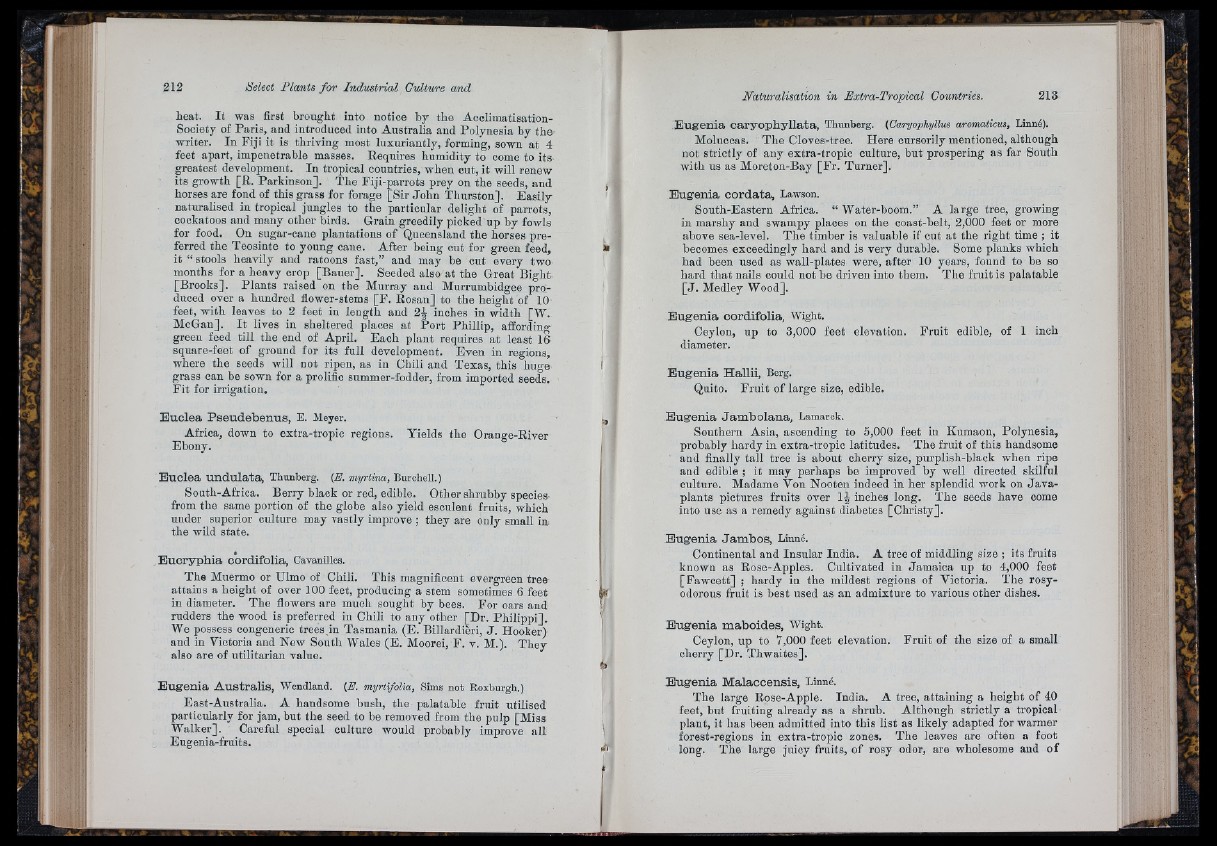
heat. I t was first brought into notice by the Acclimatisation-
Society of Paris, and introduced into Australia and Polynesia by thO'
writer. In Fiji it is thriving most luxuriantly, forming, sown at 4
feet apart, impenetrable masses. Requires humidity to come to its
greatest development. In tropical countries, when cut, it will renew
its growth [R. Parkinson]. The Piji-parrots prey on the seeds, and
horses are fond of this grass for forage [Sir John Thurston]. Easily
naturalised in tropical jungles to the particular delight of parrots,
cockatoos and many other birds. Grain greedily picked up by fowls
for food. On sugar-cane plantations of Queensland the horses preferred
the Teosinte to young cane. After being cut for green feed,
it “ stools heavily and ratoons fast,” and may be out every two
months for a heavy crop [Bauer]. Seeded also a t the Great Bight
[Brooks]. Plants raised on the Murray and Murrumbidgee pro-
duced over a hundred flower-stem s
F. Rosan] to the height of 10
feet, with leaves to 2 feet in lengt
and 2 \ inches in width [W.
McGan]. I t lives in sheltered places at P o rt Phillip, affording
green feed till the end of April. Each plant requires a t least 16
square-feet of ground for its full development. Even in regions,
where the seeds will not ripen, as in Chili and Texas, this huge
grass can be sown for a prolific summer-fodder, from imported seeds.
F it for irrigation.
Naturalisation in Extra-Tropical Countries. 213
Eugenia caryophyllata, Thunberg. (Garyophyllus aromaticus, Linné).
Moluccas. The Cloves-tree. Here cursorily mentioned, although
not strictly of any extra-tropic culture, but prospering as far South
with us as Moreton-Bay [F r. Turner].
Eugenia cordata, Lawson.
South-Eastern Africa. “ Water-boom.” A large tree, growing
in marshy and swampy places on the coast-belt, 2,000 feet or more
above sea-level. The timber is valuable if cut a t the right time ; it
becomes exceedingly hard and is very durable. Some planks which
had been used as wall-plates were, after 10 years, found to be so
hard th a t nails could not he driven into them. The fruit is palatable
[ J . Medley Wood].
Eugenia cordifolia, Wight.
Ceylon, up to 3,000 feet elevation,
diameter.
Eugenia Hallii, Berg.
Quito. F ru it of large size, edible.
F ru it edible, of 1 inch
Euclea Pseudebenus, E. Meyer.
Africa, down to extra-tropic regions.
Ebony.
Yields the Orange-River
Euclea undulata, Thunberg. (A myrtina, Burchell. )
South-Africa. Berry black or red, edible. Other shrubby species-
from the same portion of the globe also yield esculent fruits, which
under superior culture may vastly improve ; they are only small in
the wild state.
Eucrypbia cordifolia, Cavanilles.
The Mnermo or Ulmo of Chili. This magnificent evergreen tree
attains a height of over 100 feet, producing a stem sometimes 6 feet
in diameter. The flowers are much sought by bees. For oars and
rudders the wood is preferred in Chili to any other [D r. Philippi].
We possess congeneric trees in Tasmania (E. Biliardièri, J . Hooker)
and in Victoria and New South Wales (E. Moorei, F. v. M.). They
also are of utilitarian value.
Eugenia Jambolana, Lamarck.
Southern Asia, ascending to 5,000 feet in Kumaon, Polynesia,
probably liardy in extra-tropic latitudes. The fruit of this handsome
and finally tall tree is about cherry size, purplish-black when ripe
and edible ; it may perhaps be improved by well directed skilful
culture. Madame Von Nooten indeed in her splendid work on Java-
plants pictures fruits over 1 ^ inches long. The seeds have come
into use as a remedy against diabetes [Christy].
Eugenia Jambos, Linné.
Continental and Insular India. A tree of middling size ; its fruits
known as Rose-Apples. Cultivated in Jamaica up to 4,000 feet
[Fawcett] ; hardy in the mildest regions of Victoria. The rosy-
odorous fruit is best used as au admixture to various other dishes.
Eugenia maboides, Wight.
Ceylon, up to 7,000 feet elevation. F ru it of the size of a small
cherry [Dr. Thwaites].
Eugenia Australis, Wendland. (E. myrtifolla, Sims not Roxburgh.)
East-Australia. A handsome bush, the palatable fruit utilised
particularly for jam, but the seed to be removed from the pulp [Miss
Walker]. Careful special culture -would probably improve a ll
Eugenia-fruits.
Eugenia Malaccensis, Linné.
The large Rose-Apple. India. A tree, attaining a height of 40
feet, but fruiting already as a shrub. Although strictly a tropical
plant, it has been admitted into this list as likely adapted for warmer
forest-regions in extra-tropic zones. The leaves are often a foot
long. The large juicy fruits, of rosy odor, are wholesome and o f